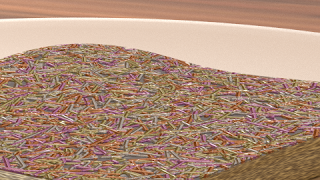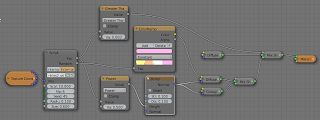
(Whether you think this is a tasty image probably depends on you being a five year old or not :-)
There are a couple of issues with the original code:
- Unnecessary functions
- When the code was written OSL was lacking an implementation of the function to calculate the distance to a line segment. This is no longer the case and the functionality is provided by the three argument version of the
distance()function. - Unsophisticated use of cellnoise
- In the original code we added all sorts of vectors to get more than one uncorrelated cell noise value but in fact all noise variants in OSL support 4 dimensions so we can use a vector plus an additional value to get different noise values for a given cell.
- Use of a deprecated function
- The
cellnoise()function is deprecated and we should usenoise("cell", ...)in stead. - Unnecessary include
stdosl.his automatically included by Blender already so there is no need for us to include it again.
Code and node setup
The cleaned up code is pretty straight forward (and quite a bit shorter):
shader sprinkles(
point Pos = P,
float Scale = 1,
int Np = 1,
int Seed = 42,
float Radius = 0.05,
float Size = 1,
output float Fac = 0,
output float Random = 0
){
point p = Pos * Scale;
point f = floor(p);
int xx,yy,np;
vector one = 1;
for( xx=-1; xx<=1; xx++){
for( yy=-1; yy<=1; yy++){
point ff = f + vector(xx,yy,0);
float u=Seed;
for( np=0; np < Np; np++){
vector pd1 = 2*noise("cell",ff,u)-one;
vector pd2 = 2*noise("cell",ff,u+1)-one;
point p1 = ff + pd1;
point p2 = ff + pd2;
p2 = (p2 - p1)*Size+p1;
// reduce to 2D
p1[2]=0;
p2[2]=0;
p [2]=0;
float r = distance(p1,p2,p);
if ( r < Radius ) {
Fac = 1 - r/Radius;
Random = noise("cell",ff,u+2);
}
u+=3;
}
}
}
}
The node setup used to make the image at the top looks like this: 
No comments:
Post a Comment